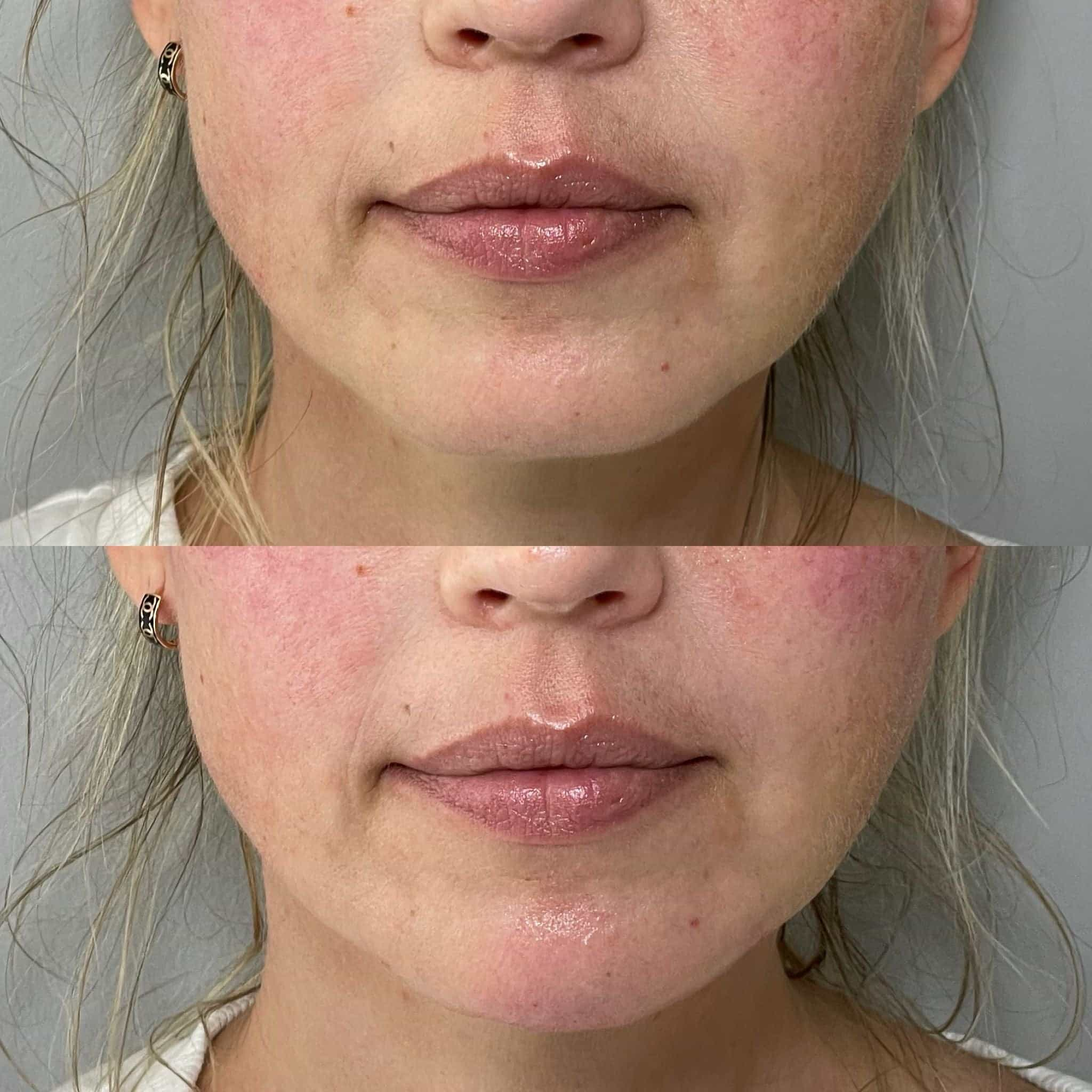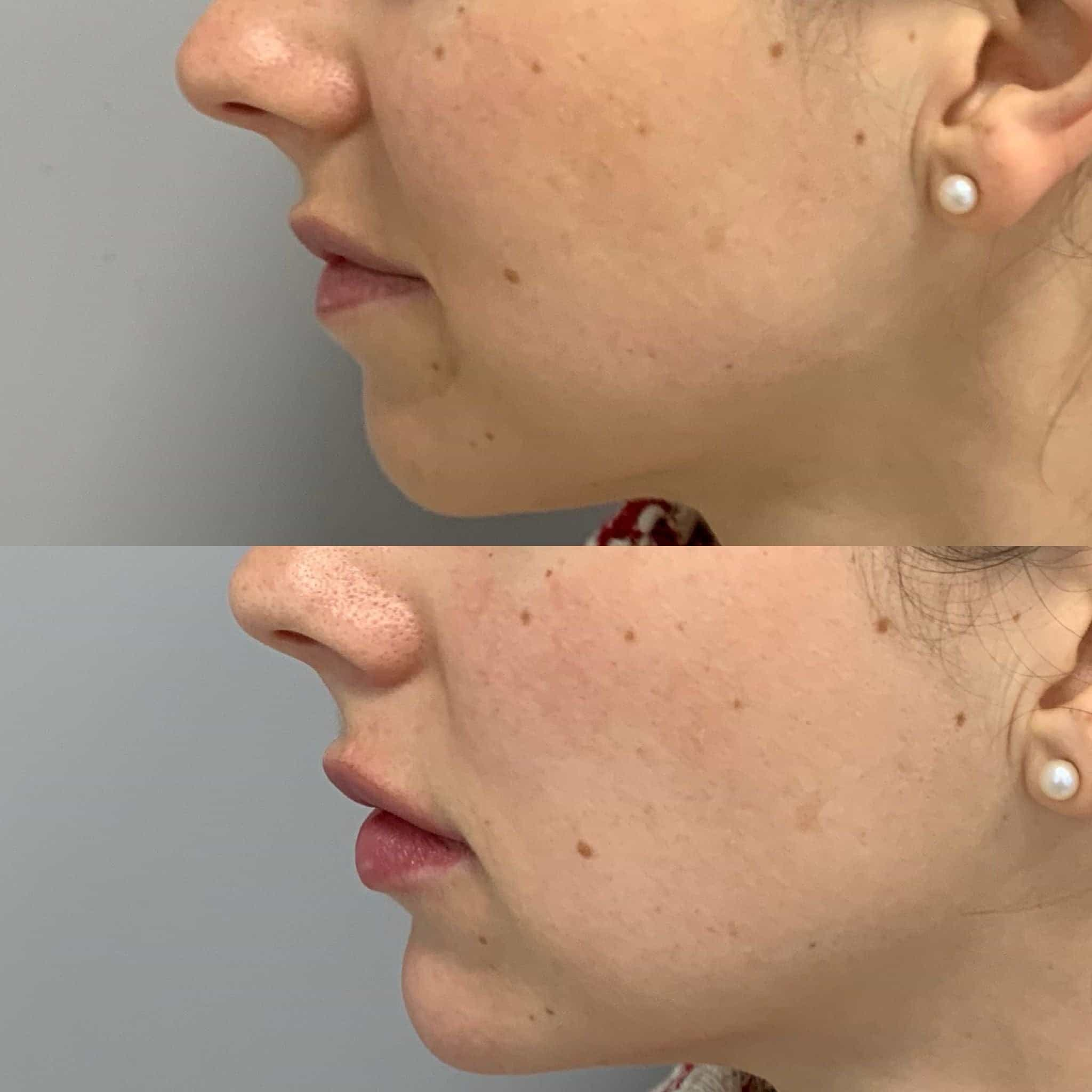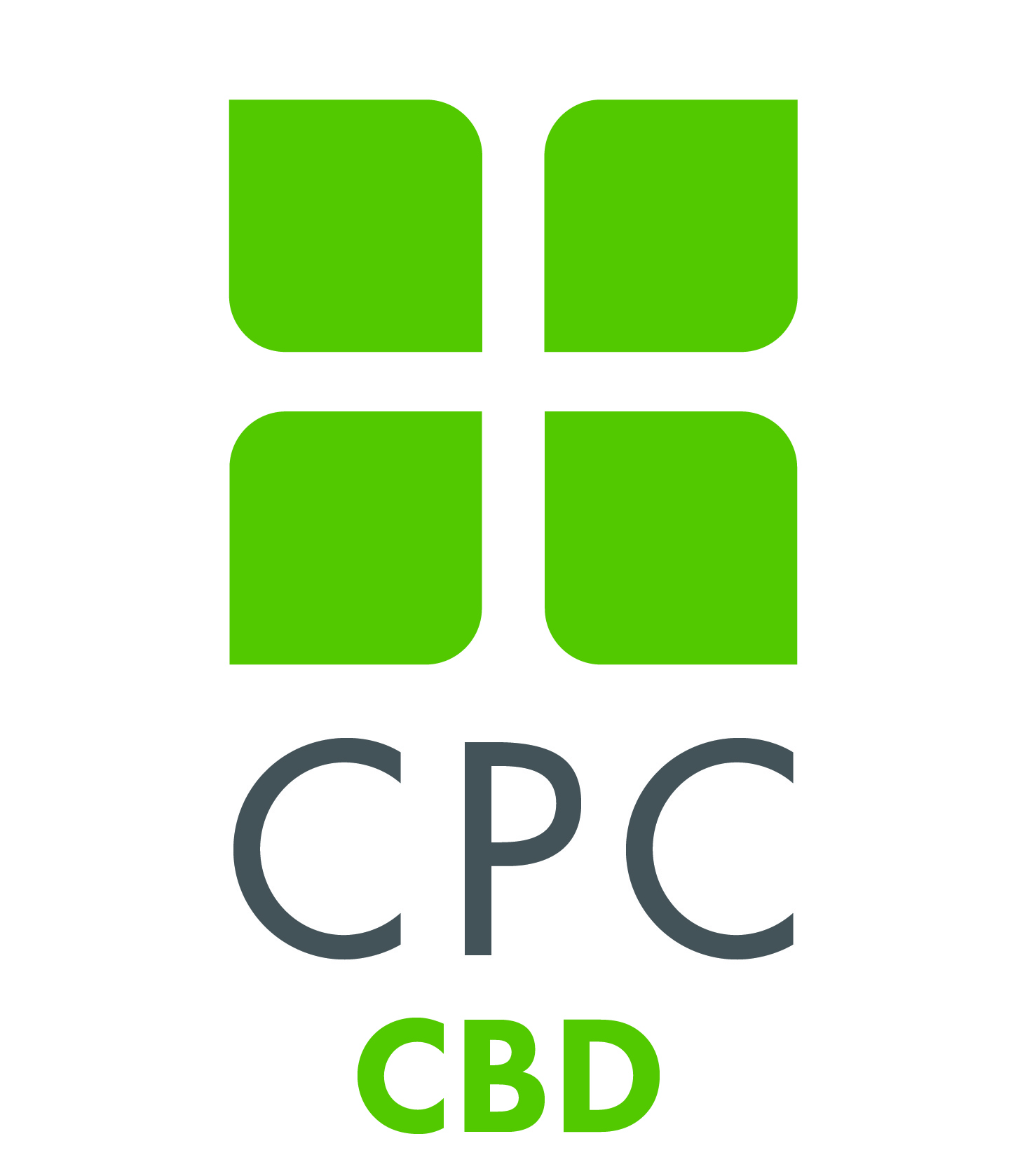How To Fix A Dimpled Chin With Non-Surgical Solutions
Dermal Fillers
A prominent chin can create balance and harmony in facial features, but for those with recessed or dimpled chins, this aesthetic goal may seem out of reach. Thankfully, non-surgical solutions like dermal fillers offer a safe and effective way to address these concerns.
Types of Fillers

Dermal fillers are injectables made from hyaluronic acid, a naturally occurring substance in the body that helps maintain skin hydration and volume. These fillers can be strategically placed under the skin to plump up areas, smooth wrinkles, and enhance facial contours. For dimpled chins, dermal fillers provide a solution by adding volume to the chin area, minimizing the appearance of indentations.
There are different types of hyaluronic acid fillers available, each with varying viscosities and properties suited for specific applications. Some popular options include:

– Restylane Lyft**: This filler is designed to lift and volumize areas like the chin, providing a more defined and sculpted appearance.
– Juvederm Voluma XC**: Known for its long-lasting results, this filler adds volume and projection to the chin, effectively addressing dimples and creating a smoother profile.
Procedure and Recovery
The procedure of using dermal fillers to address a dimpled chin is relatively straightforward and can be performed in a doctor’s office or medical spa. A topical anesthetic will be applied to numb the area, followed by the injection of the chosen filler under the skin. Multiple injections may be necessary to achieve the desired results.
- After the procedure, you may experience some mild swelling, redness, and bruising which typically subside within a few days.
- You can resume your normal activities immediately following the treatment.
- Avoid applying makeup or touching the treated area for at least 24 hours to minimize irritation.
Pros and Cons
Dermal fillers offer numerous benefits for addressing a dimpled chin. They provide a non-surgical solution, eliminating the need for invasive procedures and lengthy recovery times. The results are typically noticeable immediately after treatment, with further improvement as the filler settles in.
Dermal fillers can also be customized to address individual needs, allowing for subtle or more dramatic enhancements based on desired outcomes. The hyaluronic acid used in these fillers is naturally occurring in the body and biocompatible, making it a safe option with minimal risk of adverse reactions.
However, it’s important to consider potential downsides before opting for dermal fillers. The results are temporary, typically lasting anywhere from six months to two years depending on the type of filler used. This means repeat treatments are required to maintain the desired outcome. Dermal fillers can also cause side effects such as bruising, swelling, redness, and itching, although these are usually mild and transient.
Additionally, it’s crucial to choose a qualified and experienced practitioner who understands facial anatomy and filler techniques. Improper injection or excessive filler use can lead to unnatural-looking results or complications.
Fat Grafting
Fat grafting is another non-surgical option for addressing dimpled chins. This procedure involves harvesting fat from one area of the body, such as the abdomen or thighs, and processing it before injecting it into the chin. Fat grafting offers a permanent solution, as the transplanted fat cells integrate with the surrounding tissue.
Procedure and Recovery
Fat grafting is a surgical procedure that involves transplanting fat cells from one area of the body to another. In the context of a dimpled chin, fat grafting can be used to add volume and smooth out indentations.
During the procedure, fat is removed from a donor site, such as the abdomen or thighs, through liposuction. The extracted fat is then processed to separate the viable fat cells. These purified fat cells are then injected into the chin area using a fine cannula.
Recovery from fat grafting typically takes several weeks. Swelling and bruising are common side effects, and it may take time for the transplanted fat to settle and integrate fully with the surrounding tissue.
While fat grafting offers a potentially permanent solution compared to temporary fillers, it is important to note that some of the transplanted fat may be reabsorbed by the body over time. Multiple sessions may be required to achieve the desired results.
As with any surgical procedure, there are potential risks and complications associated with fat grafting, including infection, asymmetry, and contour irregularities.
Pros and Cons
Fat grafting is a non-surgical technique that involves transferring fat from another area of your body to the chin to address dimples. The transferred fat cells integrate into the chin tissue, potentially offering a permanent solution.
One of the primary advantages of fat grafting is its potential for lasting results. Unlike dermal fillers, which need repeated injections, fat grafting can provide long-term volume enhancement.
Another benefit is that the body’s own fat is used, reducing the risk of allergic reactions or immune responses. Fat grafting also offers the possibility of improving skin texture and contour in the chin area.
However, fat grafting comes with certain considerations. It is a surgical procedure requiring anesthesia and carries risks like infection, asymmetry, and contour irregularities. The transplanted fat may not always survive fully, necessitating multiple sessions for optimal outcomes.
Additionally, recovery from fat grafting can take several weeks, involving swelling, bruising, and potential discomfort.
Microneedling
Microneedling is a minimally invasive cosmetic procedure that involves using tiny needles to create controlled punctures in the skin. These micro-injuries stimulate the body’s natural healing process, which leads to increased collagen production, improved skin texture, and reduced the appearance of scars, wrinkles, and other imperfections.
How it Works
Microneedling works by creating tiny punctures in the skin using a device with fine needles. These micro-injuries trigger the body’s natural healing response, stimulating the production of collagen and elastin, proteins that provide structure and elasticity to the skin.
This increased collagen production helps to plump up the skin, reducing the appearance of wrinkles and fine lines. It also improves skin texture by smoothing out acne scars, uneven pigmentation, and other imperfections.
Microneedling can be used on various areas of the body, including the face, neck, décolletage, and hands.
Procedure and Recovery
Microneedling is a minimally invasive cosmetic procedure that involves using tiny needles to create controlled punctures in the skin. These micro-injuries stimulate the body’s natural healing process, which leads to increased collagen production, improved skin texture, and reduced the appearance of scars, wrinkles, and other imperfections.
Microneedling works by creating tiny punctures in the skin using a device with fine needles. These micro-injuries trigger the body’s natural healing response, stimulating the production of collagen and elastin, proteins that provide structure and elasticity to the skin.
This increased collagen production helps to plump up the skin, reducing the appearance of wrinkles and fine lines. It also improves skin texture by smoothing out acne scars, uneven pigmentation, and other imperfections.
Microneedling can be used on various areas of the body, including the face, neck, décolletage, and hands.
The procedure typically involves cleansing the skin and applying a topical anesthetic. The microneedling device is then gently rolled over the treatment area, creating micro-injuries in the skin. After treatment, a soothing moisturizer or serum may be applied to calm the skin and promote healing.
Recovery from microneedling is generally quick and easy. Some mild redness, swelling, and tenderness may occur immediately after the procedure, but these symptoms usually subside within a few hours to days. Makeup can typically be applied the next day.
It’s important to protect the treated skin from sun exposure for several weeks following microneedling, as the skin may be more sensitive to UV rays.
Pros and Cons
Microneedling is a minimally invasive cosmetic procedure that involves using tiny needles to create controlled punctures in the skin. These micro-injuries stimulate the body’s natural healing process, which leads to increased collagen production, improved skin texture, and reduced the appearance of scars, wrinkles, and other imperfections.
Microneedling works by creating tiny punctures in the skin using a device with fine needles. These micro-injuries trigger the body’s natural healing response, stimulating the production of collagen and elastin, proteins that provide structure and elasticity to the skin.
This increased collagen production helps to plump up the skin, reducing the appearance of wrinkles and fine lines. It also improves skin texture by smoothing out acne scars, uneven pigmentation, and other imperfections.
Microneedling can be used on various areas of the body, including the face, neck, décolletage, and hands.
The procedure typically involves cleansing the skin and applying a topical anesthetic. The microneedling device is then gently rolled over the treatment area, creating micro-injuries in the skin. After treatment, a soothing moisturizer or serum may be applied to calm the skin and promote healing.
Recovery from microneedling is generally quick and easy. Some mild redness, swelling, and tenderness may occur immediately after the procedure, but these symptoms usually subside within a few hours to days. Makeup can typically be applied the next day.
It’s important to protect the treated skin from sun exposure for several weeks following microneedling, as the skin may be more sensitive to UV rays.
**Pros:**
– Relatively non-invasive and has minimal downtime
– Can improve various skin concerns like wrinkles, scars, and uneven pigmentation
– Stimulates collagen production for long-lasting results
– Suitable for multiple areas of the body
**Cons:**
– May cause temporary redness, swelling, and sensitivity
– Requires multiple treatments for optimal results
– Can be slightly uncomfortable during the procedure
– Not suitable for everyone (e.g., individuals with certain skin conditions or on certain medications)
Kybella Injections
For individuals seeking a non-surgical approach to address a dimpled chin, Kybella injections offer a promising solution. Kybella is an injectable treatment that permanently destroys fat cells beneath the chin, leading to a reduction in fullness and a smoother chin contour.
How it Works
Kybella (deoxycholic acid) is an injectable medication specifically designed to reduce fat under the chin, also known as submental fat or “double chin.” It works by destroying fat cells directly, leading to a noticeable reduction in fullness and improvement in chin contour.
During Kybella treatment, small injections are made beneath the chin, targeting specific areas of fat accumulation. The deoxycholic acid in Kybella disrupts the cell membranes of fat cells, causing them to dissolve and be naturally eliminated from the body.
Multiple treatment sessions are typically required to achieve the desired results, spaced several weeks apart. As fat cells are permanently destroyed, the reduction in fullness is long-lasting.
Kybella can provide a significant improvement in chin contour and facial aesthetics for individuals concerned about submental fat. It offers a non-surgical alternative to liposuction and provides noticeable and lasting results.
Procedure and Recovery
Kybella injections offer a potential solution for those seeking to address a dimpled chin without resorting to surgery. Kybella is an injectable medication composed of deoxycholic acid, a naturally occurring substance that aids in the breakdown and absorption of fats.
This medication works by targeting and destroying fat cells under the chin, resulting in a reduction of fullness and a smoother contour. Kybella is specifically designed to eliminate fat cells permanently, meaning the results are long-lasting.
The Kybella injection procedure is relatively straightforward. During the treatment, multiple small injections are administered beneath the chin, precisely targeting areas of fat accumulation. Each injection contains a dose of deoxycholic acid that gradually breaks down the targeted fat cells over time.
- It’s important to note that Kybella is typically administered in a series of sessions, spaced several weeks apart. This allows for gradual and controlled reduction of fat while minimizing any potential side effects.
- After each session, you may experience some temporary swelling, redness, or bruising around the injection sites. These symptoms usually subside within a few days.
Kybella is considered a non-surgical option for addressing a dimpled chin. As it doesn’t involve any incisions or anesthesia, recovery time is minimal. You can typically resume your normal activities immediately after treatment.
One of the most significant benefits of Kybella is its permanence. Once the fat cells are destroyed, they cannot regenerate, meaning the results are long-lasting.
Kybella: Benefits
- Non-surgical procedure
- Long-lasting results
- Can improve chin contour and facial aesthetics
Kybella: Potential Considerations
- May require multiple treatment sessions
- Temporary side effects like swelling, redness, or bruising are possible
- Not suitable for everyone (e.g., individuals with certain medical conditions)
Pros and Cons
Kybella injections offer a solution to address dimples on the chin by permanently eliminating fat cells under the skin. Kybella works by injecting deoxycholic acid, which breaks down these fat cells, leading to a reduction in fullness and a smoother chin contour.
**Pros:**
* **Permanent Results:** Unlike fillers that provide temporary volume, Kybella permanently destroys fat cells, resulting in long-lasting results.
* **Non-Surgical Procedure:** Kybella is administered through injections, eliminating the need for surgery, anesthesia, or extensive downtime.
* **Improved Chin Contour:** Kybella can effectively reduce the appearance of a double chin and create a more defined and aesthetically pleasing chin shape.
**Cons:**
* **Multiple Treatment Sessions:** Typically, several sessions spaced several weeks apart are required to achieve the desired results as fat cell destruction is gradual.
* **Temporary Side Effects:** Common side effects include swelling, redness, bruising, and tenderness at the injection sites, which usually subside within a few days.
* **Not Suitable for Everyone:** Kybella may not be appropriate for individuals with certain medical conditions or allergies.
Lifestyle Changes
Lifestyle changes can play a role in managing dimpled chins. Maintaining a healthy weight through balanced nutrition and regular exercise can help reduce overall body fat, which may contribute to the appearance of a double chin. Additionally, good posture and avoiding habits like jutting the jaw forward can improve facial proportions and minimize the prominence of indentations.
Diet and Exercise
While dermal fillers and other procedures offer effective solutions for addressing a dimpled chin, making lifestyle modifications can also contribute to a more defined appearance.
A balanced diet and regular exercise are fundamental for overall health and weight management. Excess weight gain can often accentuate the appearance of a double chin. By maintaining a healthy weight through proper nutrition and physical activity, you can reduce body fat and potentially minimize the prominence of dimples on the chin.
Furthermore, practicing good posture significantly impacts facial aesthetics. Slouching or jutting the jaw forward can exacerbate the appearance of a double chin.
Consciously maintaining an upright posture with the shoulders relaxed and the head aligned with the spine can create a more streamlined silhouette and make the chin appear less prominent.
Facial Exercises
A prominent chin can create balance and harmony in facial features, but for those with recessed or dimpled chins, this aesthetic goal may seem out of reach. Thankfully, non-surgical solutions like dermal fillers offer a safe and effective way to address these concerns. Dermal fillers are injectables made from hyaluronic acid, a naturally occurring substance in the body that helps maintain skin hydration and volume. These fillers can be strategically placed under the skin to plump up areas, smooth wrinkles, and enhance facial contours. For dimpled chins, dermal fillers provide a solution by adding volume to the chin area, minimizing the appearance of indentations.
There are different types of hyaluronic acid fillers available, each with varying viscosities and properties suited for specific applications. Some popular options include:
– Restylane Lyft**: This filler is designed to lift and volumize areas like the chin, providing a more defined and sculpted appearance.
– Juvederm Voluma XC**: Known for its long-lasting results, this filler adds volume and projection to the chin, effectively addressing dimples and creating a smoother profile.
The procedure of using dermal fillers to address a dimpled chin is relatively straightforward and can be performed in a doctor’s office or medical spa. A topical anesthetic will be applied to numb the area, followed by the injection of the chosen filler under the skin. Multiple injections may be necessary to achieve the desired results.
- After the procedure, you may experience some mild swelling, redness, and bruising which typically subside within a few days.
- You can resume your normal activities immediately following the treatment.
- Avoid applying makeup or touching the treated area for at least 24 hours to minimize irritation.
Dermal fillers offer numerous benefits for addressing a dimpled chin. They provide a non-surgical solution, eliminating the need for invasive procedures and lengthy recovery times. The results are typically noticeable immediately after treatment, with further improvement as the filler settles in. Dermal fillers can also be customized to address individual needs, allowing for subtle or more dramatic enhancements based on desired outcomes. The hyaluronic acid used in these fillers is naturally occurring in the body and biocompatible, making it a safe option with minimal risk of adverse reactions.
However, it’s important to consider potential downsides before opting for dermal fillers. The results are temporary, typically lasting anywhere from six months to two years depending on the type of filler used. This means repeat treatments are required to maintain the desired outcome. Dermal fillers can also cause side effects such as bruising, swelling, redness, and itching, although these are usually mild and transient.
Additionally, it’s crucial to choose a qualified and experienced practitioner who understands facial anatomy and filler techniques. Improper injection or excessive filler use can lead to unnatural-looking results or complications.
Facial exercises can potentially help tone the muscles in the chin area and improve muscle definition, which may contribute to a less dimpled appearance over time. However, they are not a guaranteed solution for permanently addressing deep indentations.
Some examples of facial exercises that target the chin include:
- **Chin Lifts:** Gently tilt your head back and look up towards the ceiling. As you do this, pucker your lips and press your lower jaw forward against resistance.
- Jaw Jutting: Extend your tongue as far forward as possible and hold for a few seconds. Repeat several times.
- **Fish Face:** Suck your cheeks in towards your teeth, creating a “fish face” expression, and hold for a few seconds.
It’s important to note that results from facial exercises may be subtle and require consistent effort over time. They should be performed regularly as part of a comprehensive approach to improving chin appearance.
Trust It’s Me & You Clinic for expert chin treatments by Dr. Laura Geige
- Why Does Lip Filler Hurt So Much - November 13, 2025
- What Is The Best Skin Tightening Treatment For Over 60? - November 11, 2025
- What Are The Best CBD Gummies For Reducing Inflammation - November 9, 2025

